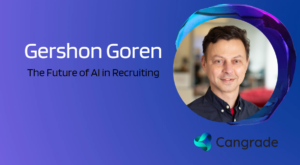
I had the pleasure of meeting and getting to know Gershon Goren, who is one of the co-founders of Cangrade. This company’s mission is to help companies make smarter hiring decisions quickly by using a data-driven approach that is up to 10 times more accurate than any other method. Their Pre-Hire Solutions leverage the power of AI and their advanced Pre-Hire Assessment to provide instant and impartial predictions of top-performing hires.
This AI technology generates customized Structured Interview Guides and Video Interviews based on candidates’ Pre-Hire Assessment results. Additionally, their Post-Hire Solutions offer complete control over the Talent Management lifecycle by measuring Workforce Engagement, facilitating remote onboarding and upskilling, and identifying the right fit for promotions and team placement. With the rise of AI technology advanced I had a ton of recruiting based questions for Gershon to answer.
Introduction:
Gershon Goren – Cofounder and CEO, Cangrade
Gershon is an accomplished technologist and entrepreneur. Gershon led the engineering group at Webdialogs, a provider of online meeting and communication solutions which was acquired by IBM. Following the acquisition Gershon acted as Chief Software Architect in the Lotus group of IBM, delivering LotusLive (now known as IBM SmartCloud) – a cloud-based collaboration suite. After leaving IBM he got involved in a number of different ventures but decided to focus on Cangrade’s mission of leveling the playing field for job seekers.
What does Cangrade offer to Talent Acquisition teams?
Cangrade helps talent acquisition teams turn their talent management data into a powerful tool for predicting job success and retention. Our AI-based pre-hire assessments predict who is most likely to achieve high levels of job success with unprecedented accuracy and without bias. We also provide insights into what kind of skills and competencies candidates and employees need to improve to better their odds of success in their current or future roles.
How will AI impact recruiting and talent sourcing?
Talent sourcing has a lot to gain from the AI revolution. Let’s start with the most basic thing, job posts. Typically, companies come up with these very undifferentiated blurbs and push them to all the sourcing venues they can fathom. Very rarely, recruiting teams have the expertise and resources to tailor these descriptions to different audiences. Using AI, with a blink of an eye, they will be able to create highly tailored versions of the same job posts for fresh graduates, for women, for communities of color, for post-docs, you name it. This is just a small example, but the larger picture here is that targeting job candidates is about to get much more personalized.
Another aspect of it, of course, will be the arrival of much more powerful career site chatbots. They will be capable of providing real assistance to jobseekers, qualifying them and guiding them in a much more intelligent way to a job application.
These are two main uses of AI that we are likely to see in talent sourcing space fairly soon.
How can AI be used to impact candidate phone screens?
It seems almost inevitable that AI will completely take over the phone screening of job candidates. And we should expect to see this technology available on the market probably in a matter of months. But is it a good idea? In my opinion, it is not. Here is why.
If the sole purpose of a phone screen is to check candidates’ basic eligibility and qualifications before proceeding to the next step in the hiring process, the question that needs to be asked is why it needs to be done in a such high-touch manner. In this case, a basic questionnaire can do just as well for a fraction of the cost.
Perhaps the main reason why some companies choose to use a phone screen is not so much the qualification and eligibility check (even though it’s the stated purpose) but rather candidate engagement and the first (however superficial) opportunity for human vetting. We are still some years away from being able to trust AI with this simple task. People, by and large, still prefer talking to other people over robots.
How can AI be used in an ATS management process?
For 30 years, the ATS was basically a glorified spreadsheet, helping recruiters track and move around jobs, applicants, interviews, etc. This is about to change. An ATS will not be a passive tracker of information, but an active part of the decision-making process. It will help recruiters create requisitions, suggest job descriptions, and predict the job requirements, but most importantly, it will help decide which candidates to hire.
Here is the rub, though. The main AI technology to power this transformation is not going to be Large Language Models or Generative AI of any sort (even though they will probably play some role as well). The technology that is best equipped for this job is Narrow AI. This is the type of AI that learns from more specialized data types and often more limited amounts of specific data. Unlike General AI which can be used to answer almost any question but with a varying degree of reliability, Narrow AI can answer only very specific questions but with high reliability.
Cangrade is a great example of such Narrow AI. It learns from specific employee data with the purpose of answering only very specific questions: how likely a candidate is to succeed and stay in a job and what they can do to improve their odds of success. You plug this technology into the ATS, connect to other sources of HRIS data, and now your ATS can route candidates through different jobs and stages, allowing human recruiters to focus only on high-potential applicants.
To this, you’ll probably say, “wait a minute, won’t this run a risk of perpetuating some of the existing biases?” This is definitely a very serious concern about any AI. But the good news here is that it’s much easier to control for biases in Narrow AI than in General AI. In fact, Cangrade even filed a patent that outlines how Cangrade makes sure that all its predictive models are bias-free.
How will ChatGPT revolutionize recruiting?
Let’s start by stating the obvious. ChatGPT and other Generative AI tools will revolutionize not only recruiting, but the nature of work as we know it. Especially when it comes to knowledge workers. The most important first step is to recognize this fact and adjust accordingly. What this adjustment means is that the hard skills that were the cornerstone of any job screening for a very long time will matter much less. Because anyone can get the necessary knowledge from ChatGPT and the like.
The cornerstone of job screening in the ChatGPT era will become soft skills. These are the skills that will help the new generation of workers connect with other people, critically examine the answers that they get from AI, know what questions to ask of AI, and, most importantly, learn to adapt to the ever-changing work and technology requirements.
We are not talking about small improvements here. We are talking about a paradigm shift.
Any future predictions within our industry?
The good news for recruiters is that they will be soon spared from the mundane and highly mechanical parts of their jobs by AI. Their time will be increasingly spent on connecting with already well-vetted candidates and focusing on their soft skills much more than their hard skills.
The flip side of it is that there will be less work overall for recruiters, and that can lead to shrinking the size of recruiting teams. But it can also lead to shorter workweeks. Most people are probably cynical about the possibility of shorter workweeks, but I believe that in the long term, a 3-4 day workweek will become the norm.
The good news for the recruitment industry is that it is equipped with much better AI-powered tools. So, it will get a seat at the strategic table along with Sales, Marketing, and R&D. Recruitment performance will be measured in the very specific metrics that are tied directly to the organization’s bottom line.
The good news for candidates is that they will benefit from the highly personalized recruitment process and ultimately very accurate placement into jobs where they are more likely to succeed, be satisfied, engaged, and stay longer.
The good news for everybody is that human capital and not AI will continue to be the key to the success of any organization for the foreseeable future.
Is there potential bad news? Of course! There are plenty of risks that the AI era brings into existence. But we have the power to minimize and mitigate them. The very first step in this process is understanding AI’s potential and its implications, recognizing the need for a radical adjustment to the new paradigm, and applying critical thinking to all information that comes our way.
Recommended Reading:
The ABC’s of Recruiting: How to preclose a candidate before the offer stage
Talent Mapping: Creating a data driven strategy
Using Boolean Strings to find healthcare professionals online
- AI Search Will Transform Talent Sourcing Forever - January 10, 2025
- Build an AI Sourcing Assistant using ChatGPT 4 - January 10, 2025
- Top Recruiting Leaders to Follow in 2025 - January 8, 2025
